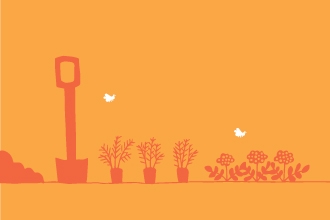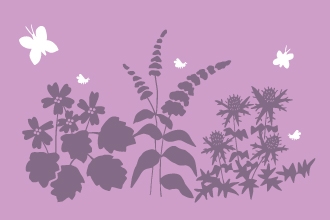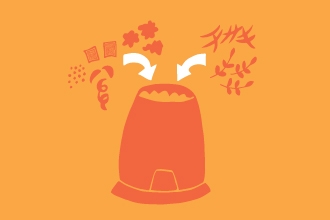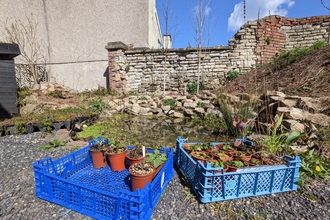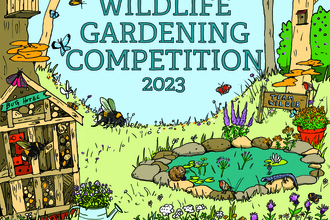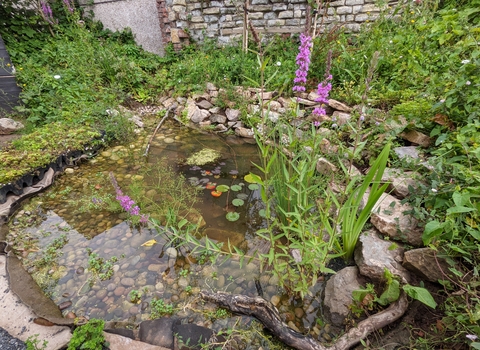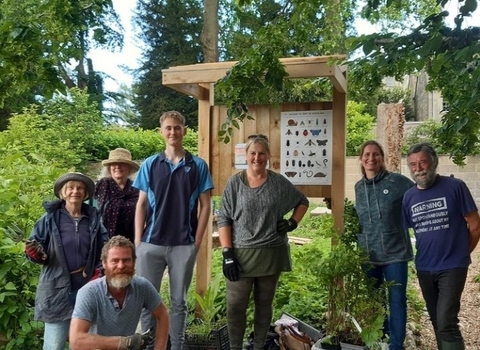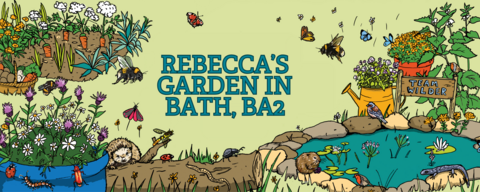
Hannah Bunn
Food Growing: Rebecca Scutt's garden
Name: Rebecca Scutt
Category: Food Growing in the wildlife gardening competition 2023
Area: Bath, BA2
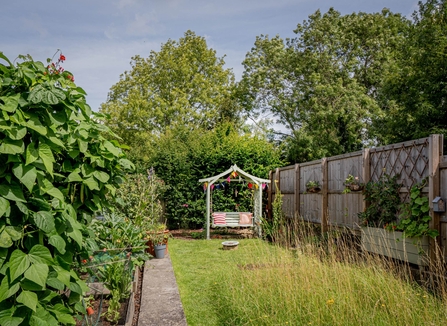
Stephanie Chadwick
What makes your garden wildlife friendly?
Rebecca: There are a number of different areas in the back garden. In the left far corner, there are the compost bins, an apple and plum tree plus raspberries and backcurrant bush. This area is quite shady and I chose to plant shade loving plants like ferns and foxgloves. There is also a frog house and piles of old wood for insects. Along the back of the garden, there is a hedge which we have clematis growing through. I hang bird feeders in this hedge with a finch mix and it is popular with house sparrows and blue tits. I wash the bird feeders regularly to reduce the spread of disease. There is also a small hole in the hedge for wildlife to get in. In the far right corner, there is a pond and beach area so that wildlife can get out of the pond if they fall in accidentally as well as a rock garden with drought tolerant plants such as sedum and majoram to encourage pollinators. Along the right hand side of the garden there is a small flower bed which has pollinator friendly plants such as echinops and oil of evening primrose for night pollinators.
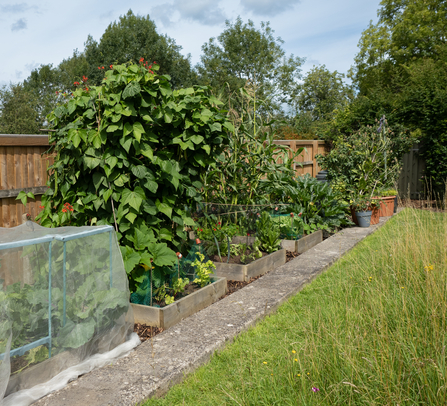
Stephanie Chadwick
There is a bee hotel installed on the fence. On the left hand side, there are five raises beds where I grow vegetables without the use of pesticides. I use peat-free compost to grow seeds and try to use as much home composted material to boost the nutrients in the soil. I also try to minimise the amount I disturb the soil and mulch it with strulch to retain moisture. I have installed an olla which minimises the use of water for the courgettes. I also capture as much water as possible using water butts. I have also installed a bird box. I like to encourage as many natural predators to manage populations of slugs, snails and aphids. To do this, I have created a wild lawn which I have spread seeds in and planted plug plants, such as oxeye daisy and fox cubs, from Grow Wilder. I have also planted teasels across the garden which is a magnet for bees.
Tell us what you love about your garden
I love my garden because I've created a space which is productive, beautiful and a home for wildlife. It's been great to make positive changes in my garden that benefit wildlife. I feel very lucky to have this space and spending time in my garden has benefitted my mental health. Both my boyfriend and I have worked together to create a space that we both love.

Stephanie Chadwick
What wildlife have you seen in your garden?
A variety of insects visit my garden including hoverflies, butterflies, beetles, lady birds and grasshoppers. There are lots of visitors who use the pond such as frogs and pond snails. I see lots of birds in the garden too including house sparrows, magpies, pigeons, blackbirds and crows. A family of blue tits used our nest box too this year. A number of mammals use the garden too. For example, squirrels, badgers, foxes and hedgehogs.
Rebecca was a finalist!
Stephanie Chadwick
To grow vegetables without the use of pesticides, it's important to encourage predators, such as birds and insects, to help manage slug, snail and aphid populations. I also net my brassicas to protect them from cabbage butterfly caterpillars, but you must do this carefully to avoid birds getting trapped in the netting.
Courgette plants need a lot of water to thrive. This year, I installed an olla which is a terracotta pot buried in the ground. I blocked the hole in the bottom, filled with water and added a lid on top. The water slowly leeches out into the soil because the terracotta pot is porous. It delivers a steady amount of water directly to the soil. I have found this to more efficient than watering the soil from above.

Stephanie Chadwick
Feeling inspired?
There are many actions for nature that benefits Rebecca's garden, food growing and enjoyment for herself! Here are a few ideas to try for yourself, with some advice from the Team Wilder Community Ecologist:
Bug hotel Materials include wooden pallets, bricks, dead leaves, woody material such as sticks/twigs etc. You can also put a planter on top of it and plant some wildflowers for pollinators too!
Build a bug hotel
Early and late flowering species Here is planting advice for early, mid and late flowering species to ensure that you benefit pollinators all year round:
The best plants for pollinators
How to attract bumblebees to your garden
Bog garden Adding a bog garden at the end of the garden, next to the pond will increase the diversity of wildlife and plants in this undisturbed corner.
Team Wilder Bog Gardens
Bird boxes A number of different birds use your feeder, such as sparrows. If possible, you could install a sparrow terrace on your fence or house (make sure that it is the eastern or northern elevations). Sparrows are a colonial species and so live in groups. Therefore, a sparrow terrace with three holes is recommended as this allows the sparrows to live close together.
Grow Wilder offer native, ethically sourced seeds and wildflowers with a local origin of Bristol. Many of the wildflower seeds have been collected from Avon Wildlife trust reserves.
Resources

West of England Combined Authority and Natural History Consortium
Be part of Team Wilder
Feeling inspired by this wildlife garden? Try something for yourself at home, in your community, school, business or land, no matter the size.
All actions for nature collectively add up and makes a difference for people and wildlife.
Share your actions for nature, like Rebecca, and motivate others to do the same.
Log your actions for nature on the map






